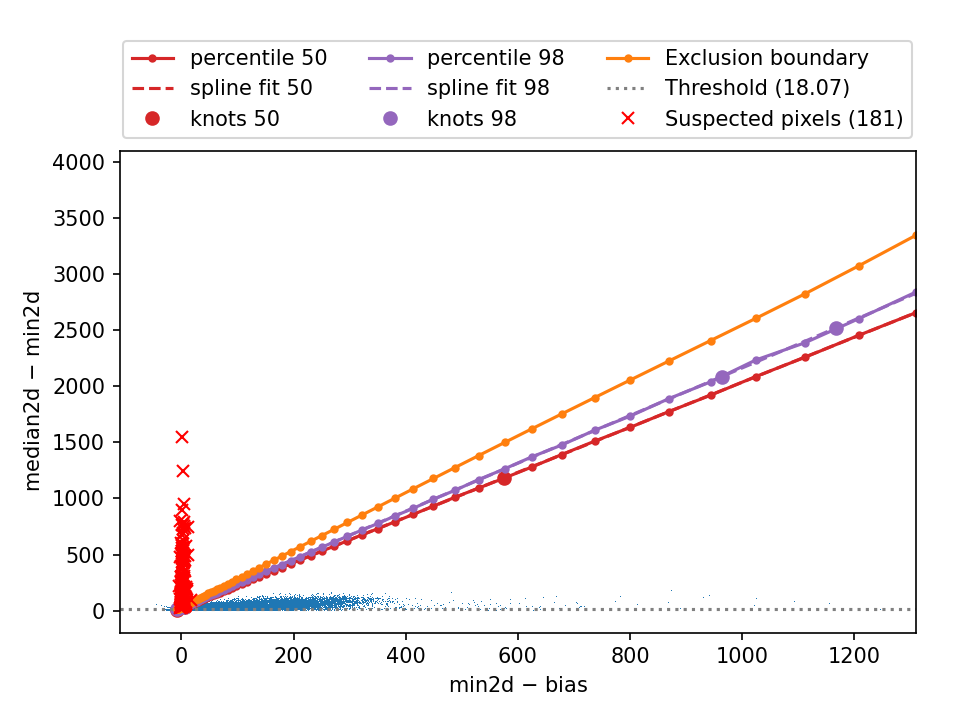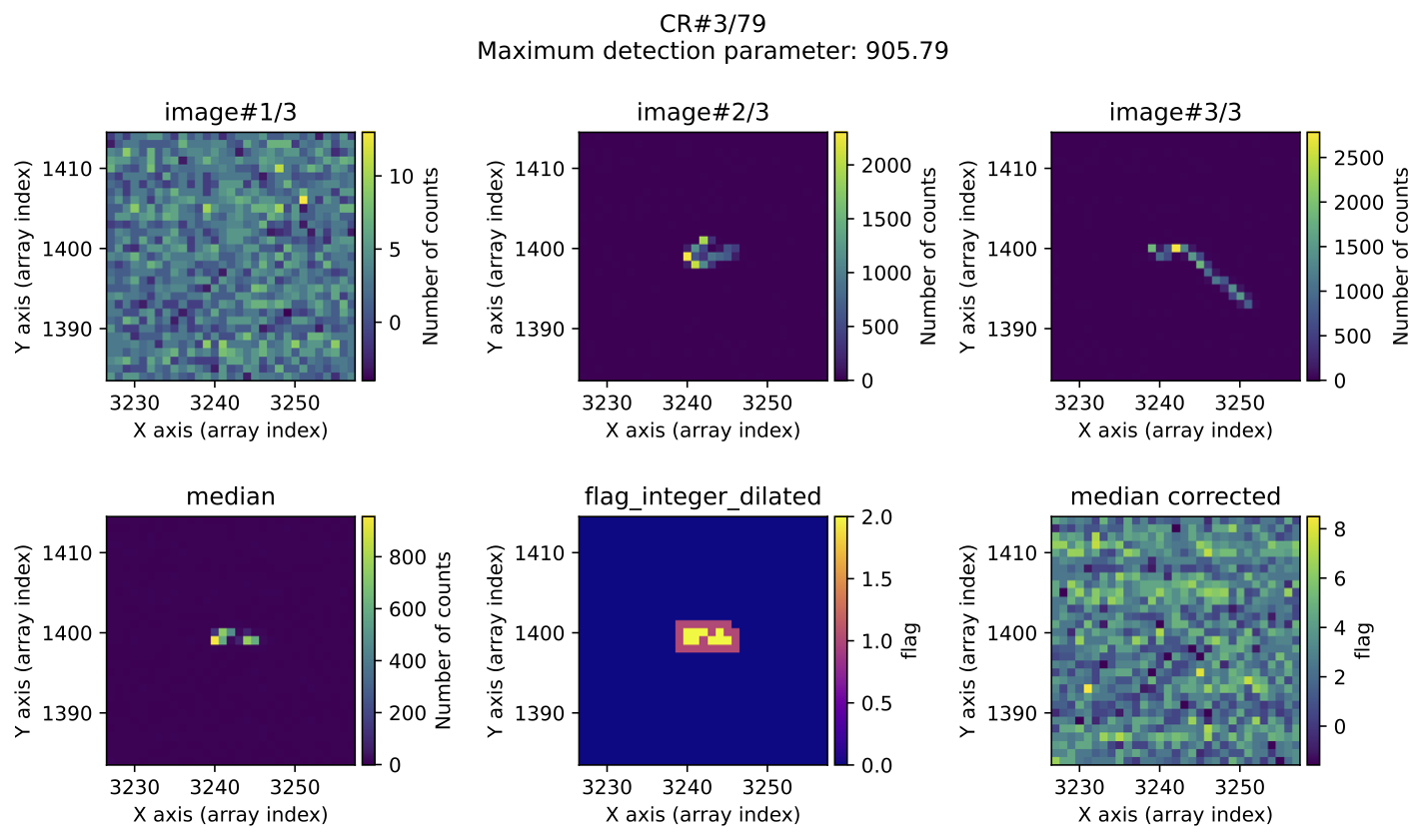CR not removed by median stacking
The different recipes in MEGARA DRP use by default a median combination of three or more images to obtain an average exposure and thus eliminate cosmic rays. However, when exposure times are long, it is not uncommon for the same pixel to be affected by a cosmic ray in consecutive exposures.
The most obvious initial solution is to closely examine the resulting image
(e.g., the final_rss.fits file) and interpolate the defective pixels using
information from neighboring pixels. However, it may be useful to employ a
procedure that automatically detects and corrects pixels affected by cosmic
rays in consecutive images, so that manual interpolation is not necessary. An
automatic procedure of this kind has been introduced in the numina package,
which can be easily invoked by modifying the default image combination method
used by MEGARA DRP.
The mediancr method
Warning
It is important to note that the ad hoc method described here is susceptible to detecting false positives and should be tested and compared with the default method (simple median combination).
The method has been tested on a limited subset of images and is not guaranteed to work optimally in general cases. Users should be aware of this limitation and use the method at their own discretion.
By properly adjusting the detection parameters, typically by trial and error, it is possible to minimize the number of false detections. On the other hand, the signal in pixels affected by a false multiple cosmic ray detection is replaced by the minimum value at each pixel (across the available exposures), so the impact on the combined image is not expected to be severe. The benefit of automatically removing pixels affected by more than one cosmic ray in the different exposures can outweigh this effect.
The described method is likely only useful when reducing science images with long exposure times. In general, it is not recommended for the reduction of calibration images.
The method can only be employed when there are three or more exposures
available, and is based on detecting pixels that simultaneously verify three
different criteria. The first two of them are shown in the following figure,
which is automically generated in the work subdirectory with the name
mediancr_diagnostic.png.

The three (or more) available individual exposures are arranged into a 3D
stack, from which it is easy to generate 2D images (with the same dimensions as
the individual exposures) that contain the minimum value min2d, maximum
value max2d, and median value median2d at each pixel along the sequence
of available exposures. On the vertical axis of the previous figure, the
difference between the median2d and min2d of each pixel is shown, while
the horizontal axis displays min2d - bias. The different solid lines correspond
to the result of performing numerical simulations using the gain, readout
noise, bias, and the minimum and maximum flatfield values. These simulations
are computed for discrete values of min2d - bias (represented as filled
circles overimposed on the lines). For each of these values, the percentiles
50 and 98 are computed. Since the simulated values are unavoidably noisy, the
predictions are fitted using splines (dashed lines, which are difficult to see
unless a zoom is performed). The exclusion boundary (orange line) is computed
by extending the difference between the spline fit to the percentiles 98 and 50
beyond the spline fit to the percentile 98. This extension is controlled by a
parameter named times_boundary_extension (see below). Pixels that lie
above the calculated exclusion boundary and above a minimum threshold in the
vertical axis of the figure (dotted gray line) are initially flagged as
suspected of having been hit by a cosmic ray in more than one exposure. An
additional requirement (not shown) is imposed: the considered pixel must have a
max2d value above three times the readout noise (this avoids pixels with
negative signal very close to the bias level in the raw images). The final set
of suspected pixels are plotted with red x’s in the figure, with the total
number of pixels displayed in the legend.
The signal in the suspected pixels is replaced, in the median2d
image, by the corresponding min2d value. This means that the
resulting image is identical to median2d, except for those corrected
pixels.
To apply this combination method, it is necessary to explicitly specify that
mediancr should be used (instead of the default median method)
in the requirements list of the observation result file. For example:
1id: 8_LcbImage_LR-R
2mode: MegaraLcbImage
3instrument: MEGARA
4frames:
5 - 0003978527-20231115-MEGARA-MegaraLcbImage.fits
6 - 0003978528-20231115-MEGARA-MegaraLcbImage.fits
7 - 0003978529-20231115-MEGARA-MegaraLcbImage.fits
8requirements:
9 method: mediancr
10 method_kwargs:
11 gain: 1.6
12 rnoise: 2.5
13 bias: 0.0
14 flatmin: 0.5
15 flatmax: 2.5
16 knots_splfit: 3
17 times_boundary_extension: 3.0
18 threshold: Null
19 minimum_max2d_rnoise: 5.0
20 interactive: True
21 dilation: 1
22 plots: True
23 semiwindow: 15
24 color_scale: minmax
25 maxplots: 10
26 extraction_offset: [+3.0]
27 reference_extinction: extinction_LP.txt
28 ignored_sky_bundles: [96] #[93, 94, 96, 97, 99, 100]
It is important to note that, in addition to specifying the method as method:
mediancr, some additional parameters must also be provided under the
method_kwargs: key, in particular:
gain: detector gain (electron/ADU). Although the MEGARA detector exhibits two different gains (1.60 and 1.73; one value for each detector half), here we can use a single value. This is not critical because the two values are not very different and the detection criterium is more sensitive to the following parameters.rnoise: readout noise (ADU)bias(default value 0.0): bias value (ADU). This must be set to zero for MEGARA because the code that applies the mediancr method receives preprocessed exposures where the bias level has already been subtracted.flatmin(default 1.0): minimum simulated normalized flatfield value.flatmax(default 1.0): maximum simulated normalized flatfield value.knots_splfit(default 3): number of inner knots employed in the spline fit to the simulated boundary data.times_boundary_extension(default 3.0): number of times that the vertical distance between the percentiles 98 and 50 of the simulated data is employed to define the exclusion boundary beyond the percentile 98.threshold(default Null; this value in the YAML file is converted to None in Python): minimum threshold formedian2d - min2dto consider a pixel as a double cosmic ray. If None, the threshold is computed automatically from the minimum boundary value in the numerical simulations.minimum_max2d_rnoise(default 5.0): minimum value ofmax2din readout noise units to consider a pixel as a double cosmic ray. This avoids false positives when a pixel exhibits a large negative value in one of the individual exposures.interactive(default False): if True, the code generates an interactive matplotlib plot with the diagnostic diagram (allowing the user to use the zoom and pan buttons). It is very convenient to set this parameter to True, interactively examine the diagnostic diagram, stop the program execution, and try changing the values offlatmin,flatmax,times_boundary_extensionandthreshold. Other parameters such asrnoiseandgaincan also be modified, although the user should take into account that the objective is to find an automatic way to select uncorrected cosmic rays, not to make use of realistic values of gain, readout noise or flatfield variation. Note that the values offlatminandflatmaxcan be used to allow the simulations to account, to some extent, for the effect of signal variations in different MEGARA exposures. This can happen, for example, in sky lines (when exposure times are long), or due to small shifts in the telescope pointing.dilation(default 1): the pixels composing each cosmic ray can be surrounded by a dilation factor, which expands the mask around the detected cosmic ray pixels. A value of zero means that no dilation is applied. Typically a value of 1 is useful, since it allow to replace the tails of cosmic rays (whose pixels exhibit a lower signal).plots(default False): if True, a PDF file calledmediancr_identified_cr.pdfis generated with the individual double cosmic rays identified. Note that enabling this option may introduce a noticeable penalty in execution time.semiwindow(default 15): the semiwindow size to plot the double cosmic rays. Only used ifplotsis True.color_scale(default minmax): the color scale employed in themediancr_identified_cr.pdfimages. Only used ifplotsis True. The valid options are minmax and zscale.maxplots(default 10): the maximum number of suspicious double cosmic rays to display. Note that setting a limit is useful when experimenting with the previous values ofgain,rnoise, etc., as it prevents generating an excessively large number of plots due to false positive detections. A negative value indicates that all the suspected double CR are displayed. This option is only used ifplotsis True.
Pixels suspected of having been affected by cosmic rays in two of the available exposures are grouped when they form a connected cluster. These are then sorted using the detection criteria, so they can be displayed in order, starting with the pixels most likely to have been affected by two cosmic rays. For each case, a figure like the one shown below is generated.

The first row shows the three individual exposures available in this example. In the second row, the left image presents the simple median combination, the center image shows the pixels detected as affected by two cosmic rays (surrounded by a 1-pixel-wide border), and the right image displays the median combination with the affected pixels replaced by the minimum value from the individual exposures.